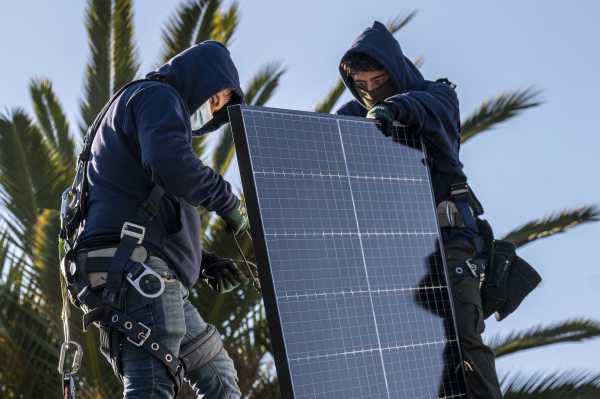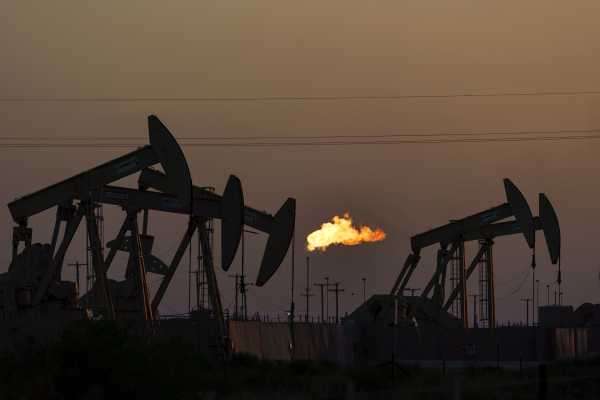
Democrats may be on the verge of passing historic climate legislation after all.
The $369 billion of climate spending in the Inflation Reduction Act that Sen. Joe Manchin (D-WV) announced on Wednesday includes funding for clean energy and electric vehicle tax breaks, domestic manufacturing of batteries and solar panels, and pollution reduction.
If the bill’s policies work as intended, it would push American consumers and industry away from reliance on fossil fuels, penalize fossil fuel companies for excess emissions of methane, and inject needed funds into pollution cleanup.
The bill would use tax credits to incentivize consumers to buy electric cars, electric HVAC systems, and other forms of cleaner technology that would lead to less emissions from cars and electricity generation, and includes incentives for companies to manufacture that technology in the United States. It also includes money for a host of other climate priorities, like investing in forest and coastal restoration and in resilient agriculture.
If Democrats pass this bill, which they can do with a simple majority under Senate rules for reconciliation, it would be the single most important legislative step the US has ever taken to combat the climate crisis.
Manchin and Senate Majority Leader Chuck Schumer claimed in their joint statement that the bill delivers enough on climate to cut pollution by roughly 40 percent by 2030. (Economic modelers at Rhodium Group said that after an initial review of the bill, the 40 percent figure was “plausible.”) The legislation helps move the US a little closer to its stated goal of cutting pollution in half within the decade.
The climate change components of the Inflation Reduction Act look shockingly similar to the version the House passed last fall, just on a slightly smaller scale. To win Manchin’s support, Democrats also reportedly struck a deal to approve a separate measure that would speed up permitting for energy infrastructure, potentially including natural gas pipelines.

The topline spending for climate is $369 billion, distributed over the next 10 years. That’s less than the House’s bill with $555 billion for climate investments, but even at the smaller sum it preserves many of the original key programs.
“Total game changer” for the climate was how Leah Stokes — a political scientist at UC Santa Barbara who has advised Democrats on the reconciliation package — put it.
Most of the Inflation Reduction Act’s investments target climate change
Climate is the biggest portion of the Inflation Reduction Act’s spending. The bill also includes funding for the Affordable Care Act and offsets the spending with prescription drug reform and setting a corporate minimum tax.
The new deal retains most of the key programs of the House’s Build Back Better Act, including consumer tax credits for solar panels and electric vehicles and funding for domestic clean energy manufacturing.
Clean energy and electric vehicles: There is a large mix of tax breaks intended to bring down the costs of solar, wind, batteries, cars, heat pumps, and other clean technology. The idea is to drive as much renewable development as possible in the heaviest-polluting parts of the economy: transportation and electricity generation.
One type of tax credits would be aimed at clean energy companies to deploy more solar, wind, and batteries on the grid, extending existing credits another 10 years.
The second type would seek to drive more consumption of renewables, offering Americans incentives for installing heat pumps, adopting solar, and buying electric cars.
On electric cars, for example, consumers would get $7,500 per new vehicle and about $4,000 for a used vehicle until 2032, but with some new restrictions on where the batteries were manufactured and income limits (explored in depth on Twitter by Bloomberg’s Tom Randall).
Some of these programs specifically help low-income people, like a $9 billion home energy rebate program to focus on retrofits and electrifying home appliances; an additional $1 billion helps make public housing more energy-efficient.
The bill also creates a National Green Bank, a program that would help launch and leverage private funding for clean projects.
Fossil fuels: The bill makes some strides on the second most problematic climate pollutant, methane. Methane is 86 times more powerful a greenhouse gas than carbon over a 20-year period, and it’s also an incredibly leaky gas that is emitted at any point in oil and gas production — drilling at the wellhead, compressor stations, and liquefied natural gas terminals. For the first time, Congress would set some industry-wide limits on methane leakage. Oil and gas companies that emit above a certain level of methane across all operations trigger a fee that will escalate over time. There’s also a new royalty fee on all methane extracted from public lands, including the common practice of venting and flaring. And to enforce all this, there is additional funding for monitoring methane leaks for oil operators and the Environmental Protection Agency.
There are some changes to the fees the oil industry pays to produce on public lands and water as well. The bill raises royalty rates for the oil industry and raises minimum bids (from $2 an acre to $10). The environmental group Center for Western Priorities noted, though, that the bill also includes some new incentives for oil leasing, like requiring the Department of Interior to expand offshore oil offerings.

Pollution reduction and environmental justice: There’s $60 billion for overall environmental justice priorities: $15 billion of that funding goes to a host of priorities like clean energy and emissions reductions specifically for low-income and disadvantaged communities. Community groups, governments, and tribes can also qualify for $3 billion in block grants for programs like cleaning up abandoned mines, monitoring air quality, and improving extreme weather resilience. And the bill contains $3 billion to restore and reconnect communities that are divided by highways.
Industrial pollution: Right now, industry is the US’s third most polluting sector, after transportation and power. By 2030, it could be the most polluting sector. While cleaner cars and renewables are off-the-shelf technologies that have to be adopted at a wider scale to make these sectors cleaner, heavy industry still relies on fossil fuels because of the high heat that’s needed to produce raw materials. So the bill helps in this sector by incentivizing energy efficiency at industrial sites to cut their footprint.
Domestic manufacturing of clean energy: There’s another $60 billion in incentives and financing for boosting domestic manufacturing of clean energy technologies.
Most of those incentives will go to accelerating US manufacturing of solar panels, wind turbines, batteries, and critical minerals, and to help build the facilities that would make electric vehicles.
The inclusion of $500 million for heat pumps and critical minerals is new, providing funding for Biden’s use of the Defense Authorization Act to boost manufacturing for the energy-efficient technology.
In an interview before the deal was announced, Jason Walsh, executive director of the environment- and labor-focused BlueGreen Alliance, noted why the domestic manufacturing for batteries, solar, and offshore wind is so important. “Those are big investments, and they’re risky investments. And if we expect manufacturers to make them in the United States, they’re going to need to have some long-term policy certainty and support.”
The bigger picture for US climate action
The news that climate was back on the table came as a relief to advocates who have spent 18 months fighting for a climate deal’s passage. “I believe this proposal passes the climate test: including emissions reductions, good-paying union jobs, and investments in justice for disadvantaged communities,” Sen. Ed Markey (D-MA) said in a statement. (Markey has previously coined “No climate, no deal.”)
Without any new action from Congress or the president, economic modelers at Rhodium Group estimated that climate emissions are on track to be, by 2030, somewhere between 24 percent and 35 percent lower than they were in 2005, the peak year for carbon emissions. That’s not a lot, even if it sounds like it: Biden had set a target under the Paris climate agreement of slashing those 2005 levels in half by the end of the decade.
Even if the Inflation Reduction Act passes, it doesn’t necessarily get the US all the way there. Senate Democrats estimated the act would get the US to a 40 percent cut by 2030.
Still, this is a long way from the bleak picture last week, when it looked as though Biden would have few limited regulatory options left for tackling climate change. While Biden has faced pressure from the left to declare a climate emergency, his powers and lasting impact would be far more limited than anything Congress could do.
It’s not a sure bet this will get through the Senate. Many Democratic senators quickly signaled they were ready to pass it, but Arizona Sen. Kyrsten Sinema hasn’t yet said she will support it.
For climate advocates, “we felt in the last two weeks what it would mean to not get climate investments over the finish line and how devastating that would be,” Stokes said. “This is a make-or-break moment. We’ve got to get this package through the Senate next week.”
Will you support Vox’s explanatory journalism?
Millions turn to Vox to understand what’s happening in the news. Our mission has never been more vital than it is in this moment: to empower through understanding. Financial contributions from our readers are a critical part of supporting our resource-intensive work and help us keep our journalism free for all. Please consider making a contribution to Vox today.
Sourse: vox.com